Professional Communication Practice: Emotional Intelligence Theory
VerifiedAdded on 2022/09/30
|6
|1522
|28
Report
AI Summary
This report delves into the application of emotional intelligence within a professional setting, specifically focusing on improving the workplace environment. It examines the Emotional Intelligence Theory, highlighting the importance of self-awareness, self-regulation, social skills, empathy, and motivation for effective management. The report analyzes a scenario involving a manager in an accounting firm who needs to address issues with a junior accountant. It explores the manager's approach to resolving organizational conflicts, emphasizing the significance of non-verbal communication methods, including facial expressions, body posture, gestures, paralanguage, and eye contact. The report provides practical strategies for managers to establish good relationships with their employees, understand their problems, and create a healthy and cooperative work environment. The analysis includes references to support the concepts discussed.
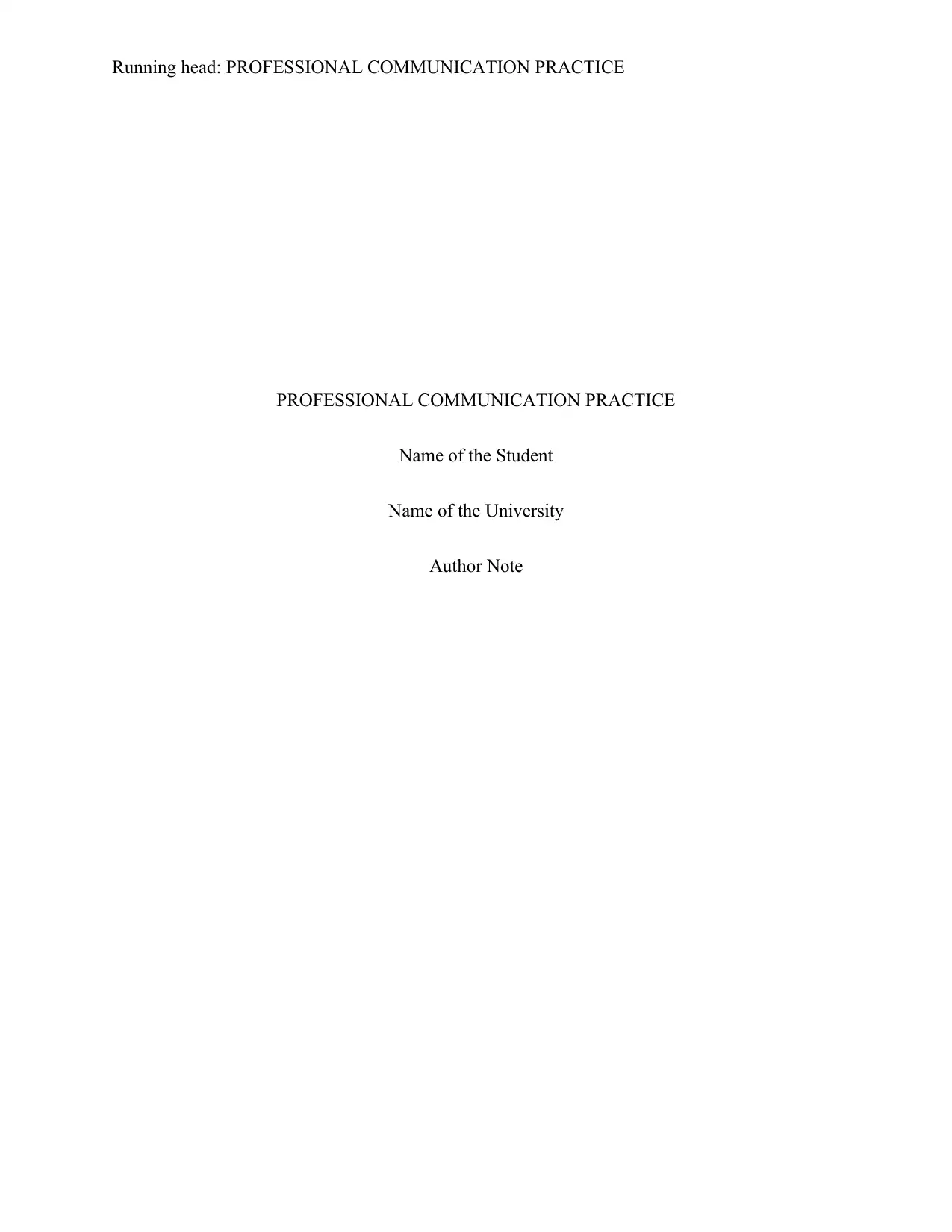
Running head: PROFESSIONAL COMMUNICATION PRACTICE
PROFESSIONAL COMMUNICATION PRACTICE
Name of the Student
Name of the University
Author Note
PROFESSIONAL COMMUNICATION PRACTICE
Name of the Student
Name of the University
Author Note
Paraphrase This Document
Need a fresh take? Get an instant paraphrase of this document with our AI Paraphraser
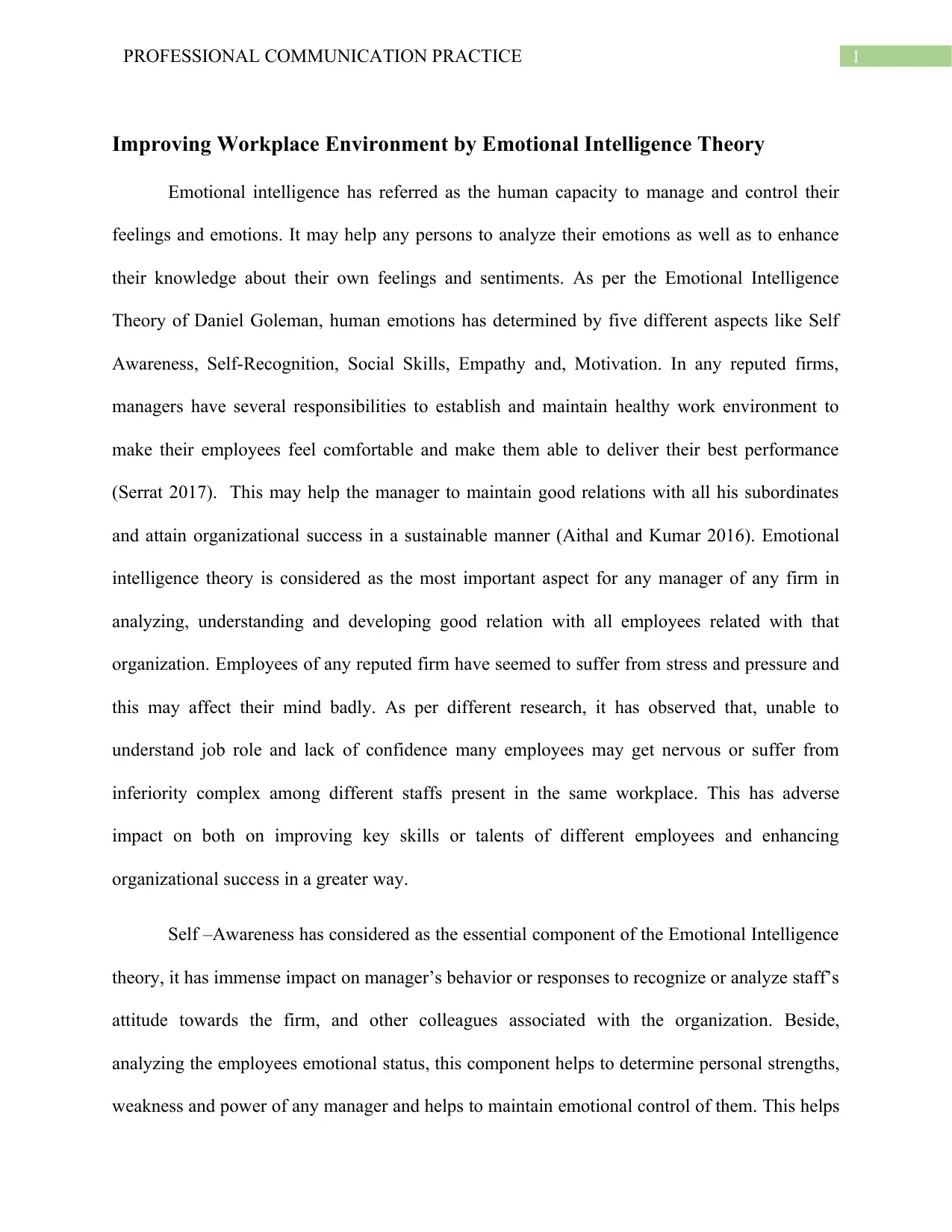
1PROFESSIONAL COMMUNICATION PRACTICE
Improving Workplace Environment by Emotional Intelligence Theory
Emotional intelligence has referred as the human capacity to manage and control their
feelings and emotions. It may help any persons to analyze their emotions as well as to enhance
their knowledge about their own feelings and sentiments. As per the Emotional Intelligence
Theory of Daniel Goleman, human emotions has determined by five different aspects like Self
Awareness, Self-Recognition, Social Skills, Empathy and, Motivation. In any reputed firms,
managers have several responsibilities to establish and maintain healthy work environment to
make their employees feel comfortable and make them able to deliver their best performance
(Serrat 2017). This may help the manager to maintain good relations with all his subordinates
and attain organizational success in a sustainable manner (Aithal and Kumar 2016). Emotional
intelligence theory is considered as the most important aspect for any manager of any firm in
analyzing, understanding and developing good relation with all employees related with that
organization. Employees of any reputed firm have seemed to suffer from stress and pressure and
this may affect their mind badly. As per different research, it has observed that, unable to
understand job role and lack of confidence many employees may get nervous or suffer from
inferiority complex among different staffs present in the same workplace. This has adverse
impact on both on improving key skills or talents of different employees and enhancing
organizational success in a greater way.
Self –Awareness has considered as the essential component of the Emotional Intelligence
theory, it has immense impact on manager’s behavior or responses to recognize or analyze staff’s
attitude towards the firm, and other colleagues associated with the organization. Beside,
analyzing the employees emotional status, this component helps to determine personal strengths,
weakness and power of any manager and helps to maintain emotional control of them. This helps
Improving Workplace Environment by Emotional Intelligence Theory
Emotional intelligence has referred as the human capacity to manage and control their
feelings and emotions. It may help any persons to analyze their emotions as well as to enhance
their knowledge about their own feelings and sentiments. As per the Emotional Intelligence
Theory of Daniel Goleman, human emotions has determined by five different aspects like Self
Awareness, Self-Recognition, Social Skills, Empathy and, Motivation. In any reputed firms,
managers have several responsibilities to establish and maintain healthy work environment to
make their employees feel comfortable and make them able to deliver their best performance
(Serrat 2017). This may help the manager to maintain good relations with all his subordinates
and attain organizational success in a sustainable manner (Aithal and Kumar 2016). Emotional
intelligence theory is considered as the most important aspect for any manager of any firm in
analyzing, understanding and developing good relation with all employees related with that
organization. Employees of any reputed firm have seemed to suffer from stress and pressure and
this may affect their mind badly. As per different research, it has observed that, unable to
understand job role and lack of confidence many employees may get nervous or suffer from
inferiority complex among different staffs present in the same workplace. This has adverse
impact on both on improving key skills or talents of different employees and enhancing
organizational success in a greater way.
Self –Awareness has considered as the essential component of the Emotional Intelligence
theory, it has immense impact on manager’s behavior or responses to recognize or analyze staff’s
attitude towards the firm, and other colleagues associated with the organization. Beside,
analyzing the employees emotional status, this component helps to determine personal strengths,
weakness and power of any manager and helps to maintain emotional control of them. This helps
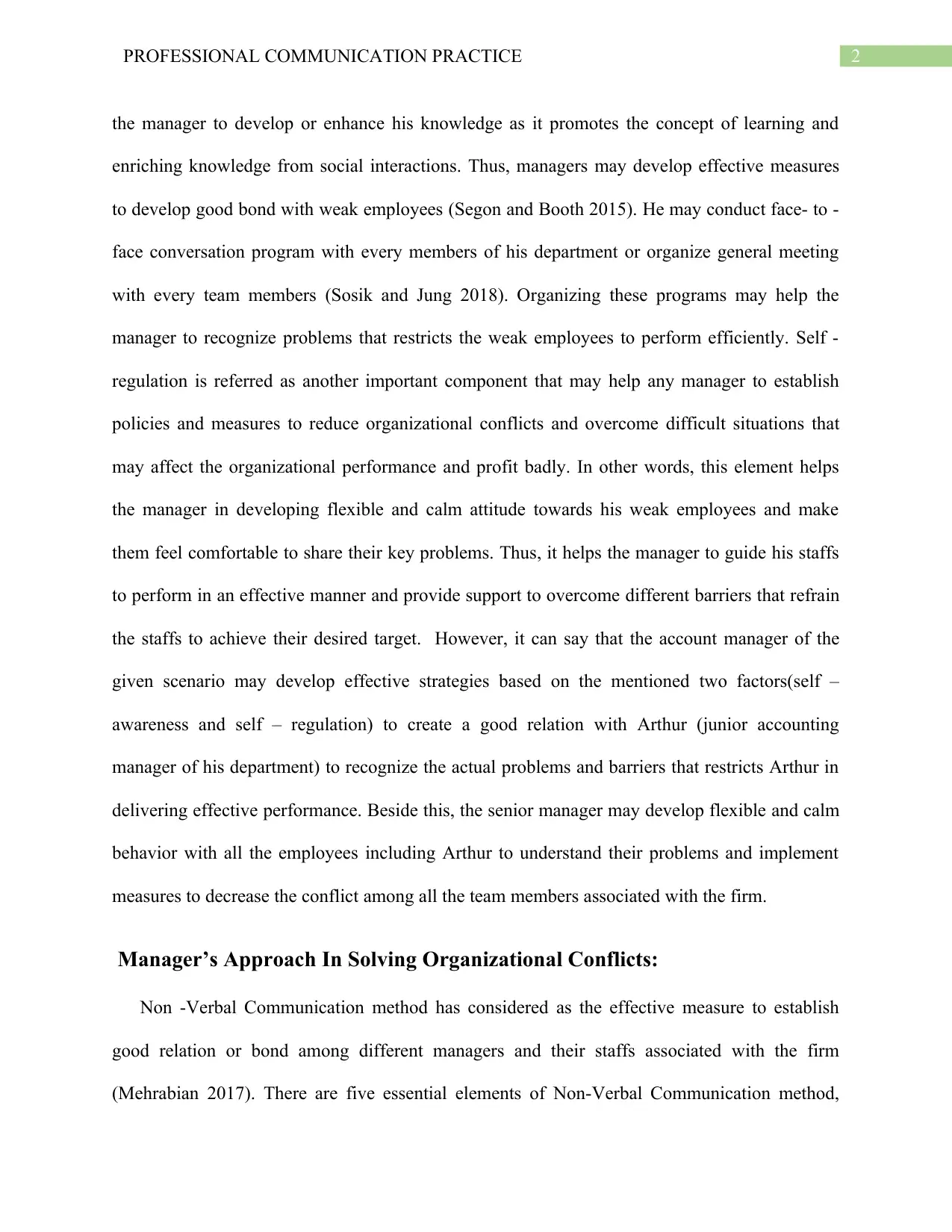
2PROFESSIONAL COMMUNICATION PRACTICE
the manager to develop or enhance his knowledge as it promotes the concept of learning and
enriching knowledge from social interactions. Thus, managers may develop effective measures
to develop good bond with weak employees (Segon and Booth 2015). He may conduct face- to -
face conversation program with every members of his department or organize general meeting
with every team members (Sosik and Jung 2018). Organizing these programs may help the
manager to recognize problems that restricts the weak employees to perform efficiently. Self -
regulation is referred as another important component that may help any manager to establish
policies and measures to reduce organizational conflicts and overcome difficult situations that
may affect the organizational performance and profit badly. In other words, this element helps
the manager in developing flexible and calm attitude towards his weak employees and make
them feel comfortable to share their key problems. Thus, it helps the manager to guide his staffs
to perform in an effective manner and provide support to overcome different barriers that refrain
the staffs to achieve their desired target. However, it can say that the account manager of the
given scenario may develop effective strategies based on the mentioned two factors(self –
awareness and self – regulation) to create a good relation with Arthur (junior accounting
manager of his department) to recognize the actual problems and barriers that restricts Arthur in
delivering effective performance. Beside this, the senior manager may develop flexible and calm
behavior with all the employees including Arthur to understand their problems and implement
measures to decrease the conflict among all the team members associated with the firm.
Manager’s Approach In Solving Organizational Conflicts:
Non -Verbal Communication method has considered as the effective measure to establish
good relation or bond among different managers and their staffs associated with the firm
(Mehrabian 2017). There are five essential elements of Non-Verbal Communication method,
the manager to develop or enhance his knowledge as it promotes the concept of learning and
enriching knowledge from social interactions. Thus, managers may develop effective measures
to develop good bond with weak employees (Segon and Booth 2015). He may conduct face- to -
face conversation program with every members of his department or organize general meeting
with every team members (Sosik and Jung 2018). Organizing these programs may help the
manager to recognize problems that restricts the weak employees to perform efficiently. Self -
regulation is referred as another important component that may help any manager to establish
policies and measures to reduce organizational conflicts and overcome difficult situations that
may affect the organizational performance and profit badly. In other words, this element helps
the manager in developing flexible and calm attitude towards his weak employees and make
them feel comfortable to share their key problems. Thus, it helps the manager to guide his staffs
to perform in an effective manner and provide support to overcome different barriers that refrain
the staffs to achieve their desired target. However, it can say that the account manager of the
given scenario may develop effective strategies based on the mentioned two factors(self –
awareness and self – regulation) to create a good relation with Arthur (junior accounting
manager of his department) to recognize the actual problems and barriers that restricts Arthur in
delivering effective performance. Beside this, the senior manager may develop flexible and calm
behavior with all the employees including Arthur to understand their problems and implement
measures to decrease the conflict among all the team members associated with the firm.
Manager’s Approach In Solving Organizational Conflicts:
Non -Verbal Communication method has considered as the effective measure to establish
good relation or bond among different managers and their staffs associated with the firm
(Mehrabian 2017). There are five essential elements of Non-Verbal Communication method,
⊘ This is a preview!⊘
Do you want full access?
Subscribe today to unlock all pages.

Trusted by 1+ million students worldwide
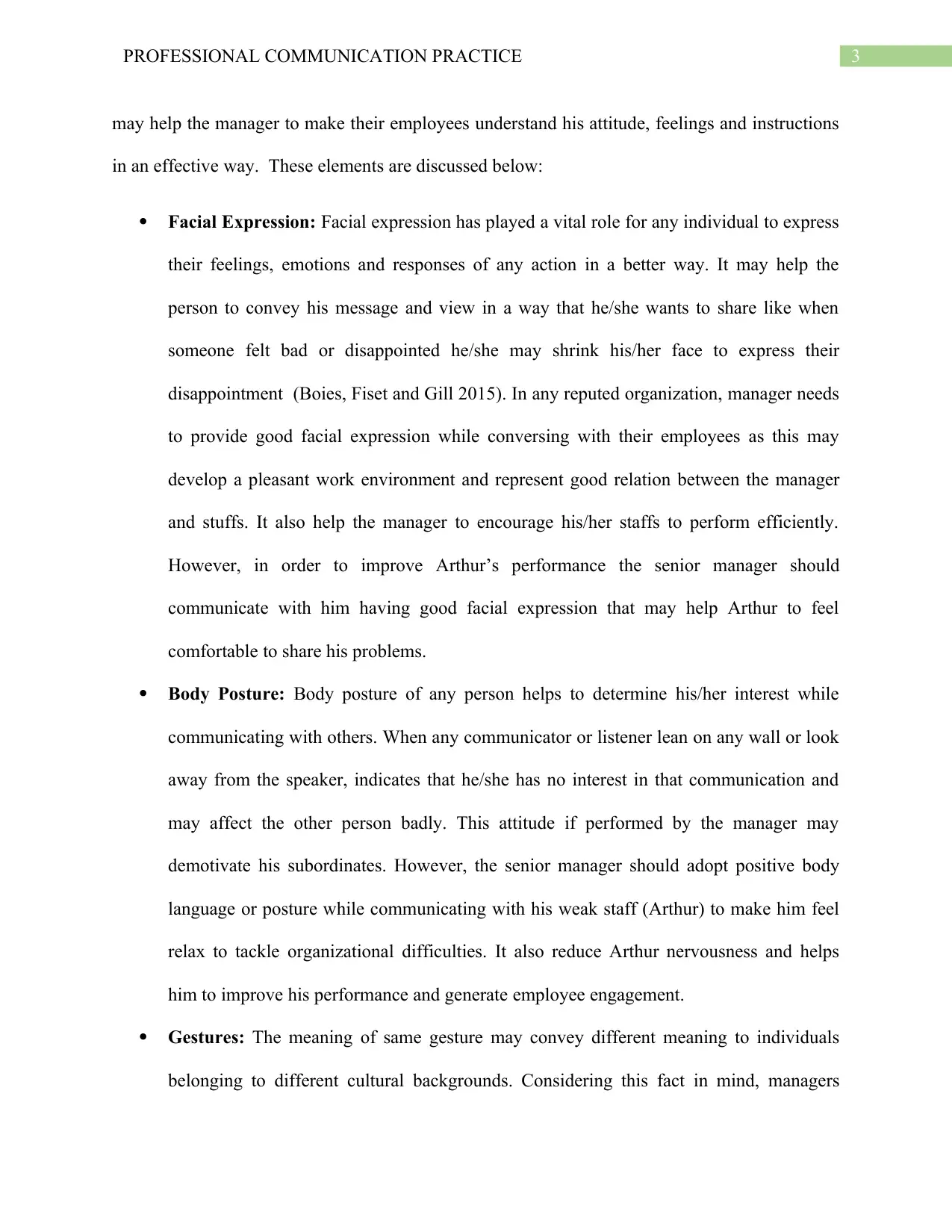
3PROFESSIONAL COMMUNICATION PRACTICE
may help the manager to make their employees understand his attitude, feelings and instructions
in an effective way. These elements are discussed below:
Facial Expression: Facial expression has played a vital role for any individual to express
their feelings, emotions and responses of any action in a better way. It may help the
person to convey his message and view in a way that he/she wants to share like when
someone felt bad or disappointed he/she may shrink his/her face to express their
disappointment (Boies, Fiset and Gill 2015). In any reputed organization, manager needs
to provide good facial expression while conversing with their employees as this may
develop a pleasant work environment and represent good relation between the manager
and stuffs. It also help the manager to encourage his/her staffs to perform efficiently.
However, in order to improve Arthur’s performance the senior manager should
communicate with him having good facial expression that may help Arthur to feel
comfortable to share his problems.
Body Posture: Body posture of any person helps to determine his/her interest while
communicating with others. When any communicator or listener lean on any wall or look
away from the speaker, indicates that he/she has no interest in that communication and
may affect the other person badly. This attitude if performed by the manager may
demotivate his subordinates. However, the senior manager should adopt positive body
language or posture while communicating with his weak staff (Arthur) to make him feel
relax to tackle organizational difficulties. It also reduce Arthur nervousness and helps
him to improve his performance and generate employee engagement.
Gestures: The meaning of same gesture may convey different meaning to individuals
belonging to different cultural backgrounds. Considering this fact in mind, managers
may help the manager to make their employees understand his attitude, feelings and instructions
in an effective way. These elements are discussed below:
Facial Expression: Facial expression has played a vital role for any individual to express
their feelings, emotions and responses of any action in a better way. It may help the
person to convey his message and view in a way that he/she wants to share like when
someone felt bad or disappointed he/she may shrink his/her face to express their
disappointment (Boies, Fiset and Gill 2015). In any reputed organization, manager needs
to provide good facial expression while conversing with their employees as this may
develop a pleasant work environment and represent good relation between the manager
and stuffs. It also help the manager to encourage his/her staffs to perform efficiently.
However, in order to improve Arthur’s performance the senior manager should
communicate with him having good facial expression that may help Arthur to feel
comfortable to share his problems.
Body Posture: Body posture of any person helps to determine his/her interest while
communicating with others. When any communicator or listener lean on any wall or look
away from the speaker, indicates that he/she has no interest in that communication and
may affect the other person badly. This attitude if performed by the manager may
demotivate his subordinates. However, the senior manager should adopt positive body
language or posture while communicating with his weak staff (Arthur) to make him feel
relax to tackle organizational difficulties. It also reduce Arthur nervousness and helps
him to improve his performance and generate employee engagement.
Gestures: The meaning of same gesture may convey different meaning to individuals
belonging to different cultural backgrounds. Considering this fact in mind, managers
Paraphrase This Document
Need a fresh take? Get an instant paraphrase of this document with our AI Paraphraser
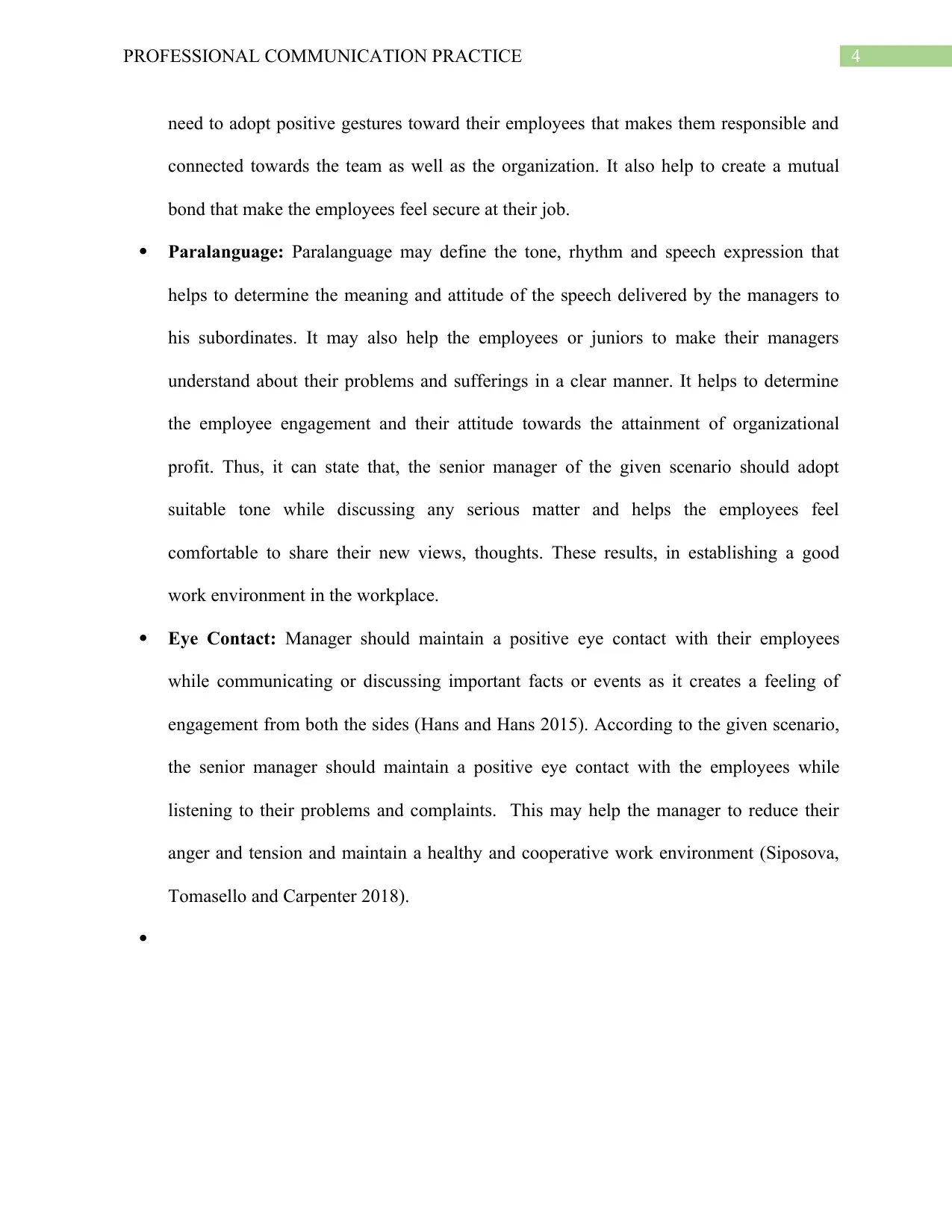
4PROFESSIONAL COMMUNICATION PRACTICE
need to adopt positive gestures toward their employees that makes them responsible and
connected towards the team as well as the organization. It also help to create a mutual
bond that make the employees feel secure at their job.
Paralanguage: Paralanguage may define the tone, rhythm and speech expression that
helps to determine the meaning and attitude of the speech delivered by the managers to
his subordinates. It may also help the employees or juniors to make their managers
understand about their problems and sufferings in a clear manner. It helps to determine
the employee engagement and their attitude towards the attainment of organizational
profit. Thus, it can state that, the senior manager of the given scenario should adopt
suitable tone while discussing any serious matter and helps the employees feel
comfortable to share their new views, thoughts. These results, in establishing a good
work environment in the workplace.
Eye Contact: Manager should maintain a positive eye contact with their employees
while communicating or discussing important facts or events as it creates a feeling of
engagement from both the sides (Hans and Hans 2015). According to the given scenario,
the senior manager should maintain a positive eye contact with the employees while
listening to their problems and complaints. This may help the manager to reduce their
anger and tension and maintain a healthy and cooperative work environment (Siposova,
Tomasello and Carpenter 2018).
need to adopt positive gestures toward their employees that makes them responsible and
connected towards the team as well as the organization. It also help to create a mutual
bond that make the employees feel secure at their job.
Paralanguage: Paralanguage may define the tone, rhythm and speech expression that
helps to determine the meaning and attitude of the speech delivered by the managers to
his subordinates. It may also help the employees or juniors to make their managers
understand about their problems and sufferings in a clear manner. It helps to determine
the employee engagement and their attitude towards the attainment of organizational
profit. Thus, it can state that, the senior manager of the given scenario should adopt
suitable tone while discussing any serious matter and helps the employees feel
comfortable to share their new views, thoughts. These results, in establishing a good
work environment in the workplace.
Eye Contact: Manager should maintain a positive eye contact with their employees
while communicating or discussing important facts or events as it creates a feeling of
engagement from both the sides (Hans and Hans 2015). According to the given scenario,
the senior manager should maintain a positive eye contact with the employees while
listening to their problems and complaints. This may help the manager to reduce their
anger and tension and maintain a healthy and cooperative work environment (Siposova,
Tomasello and Carpenter 2018).
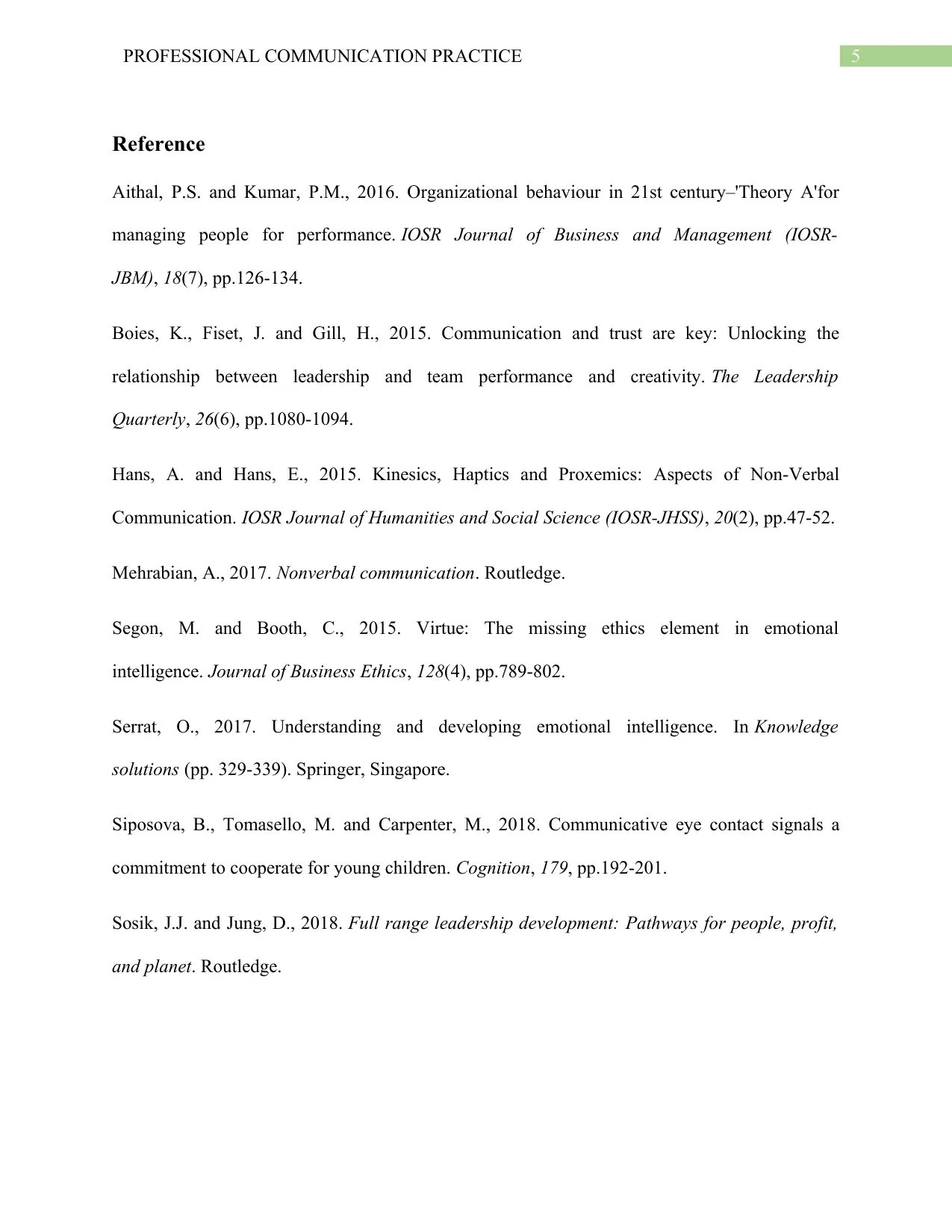
5PROFESSIONAL COMMUNICATION PRACTICE
Reference
Aithal, P.S. and Kumar, P.M., 2016. Organizational behaviour in 21st century–'Theory A'for
managing people for performance. IOSR Journal of Business and Management (IOSR-
JBM), 18(7), pp.126-134.
Boies, K., Fiset, J. and Gill, H., 2015. Communication and trust are key: Unlocking the
relationship between leadership and team performance and creativity. The Leadership
Quarterly, 26(6), pp.1080-1094.
Hans, A. and Hans, E., 2015. Kinesics, Haptics and Proxemics: Aspects of Non-Verbal
Communication. IOSR Journal of Humanities and Social Science (IOSR-JHSS), 20(2), pp.47-52.
Mehrabian, A., 2017. Nonverbal communication. Routledge.
Segon, M. and Booth, C., 2015. Virtue: The missing ethics element in emotional
intelligence. Journal of Business Ethics, 128(4), pp.789-802.
Serrat, O., 2017. Understanding and developing emotional intelligence. In Knowledge
solutions (pp. 329-339). Springer, Singapore.
Siposova, B., Tomasello, M. and Carpenter, M., 2018. Communicative eye contact signals a
commitment to cooperate for young children. Cognition, 179, pp.192-201.
Sosik, J.J. and Jung, D., 2018. Full range leadership development: Pathways for people, profit,
and planet. Routledge.
Reference
Aithal, P.S. and Kumar, P.M., 2016. Organizational behaviour in 21st century–'Theory A'for
managing people for performance. IOSR Journal of Business and Management (IOSR-
JBM), 18(7), pp.126-134.
Boies, K., Fiset, J. and Gill, H., 2015. Communication and trust are key: Unlocking the
relationship between leadership and team performance and creativity. The Leadership
Quarterly, 26(6), pp.1080-1094.
Hans, A. and Hans, E., 2015. Kinesics, Haptics and Proxemics: Aspects of Non-Verbal
Communication. IOSR Journal of Humanities and Social Science (IOSR-JHSS), 20(2), pp.47-52.
Mehrabian, A., 2017. Nonverbal communication. Routledge.
Segon, M. and Booth, C., 2015. Virtue: The missing ethics element in emotional
intelligence. Journal of Business Ethics, 128(4), pp.789-802.
Serrat, O., 2017. Understanding and developing emotional intelligence. In Knowledge
solutions (pp. 329-339). Springer, Singapore.
Siposova, B., Tomasello, M. and Carpenter, M., 2018. Communicative eye contact signals a
commitment to cooperate for young children. Cognition, 179, pp.192-201.
Sosik, J.J. and Jung, D., 2018. Full range leadership development: Pathways for people, profit,
and planet. Routledge.
⊘ This is a preview!⊘
Do you want full access?
Subscribe today to unlock all pages.

Trusted by 1+ million students worldwide
1 out of 6
Related Documents
Your All-in-One AI-Powered Toolkit for Academic Success.
+13062052269
info@desklib.com
Available 24*7 on WhatsApp / Email
![[object Object]](/_next/static/media/star-bottom.7253800d.svg)
Unlock your academic potential
Copyright © 2020–2025 A2Z Services. All Rights Reserved. Developed and managed by ZUCOL.





